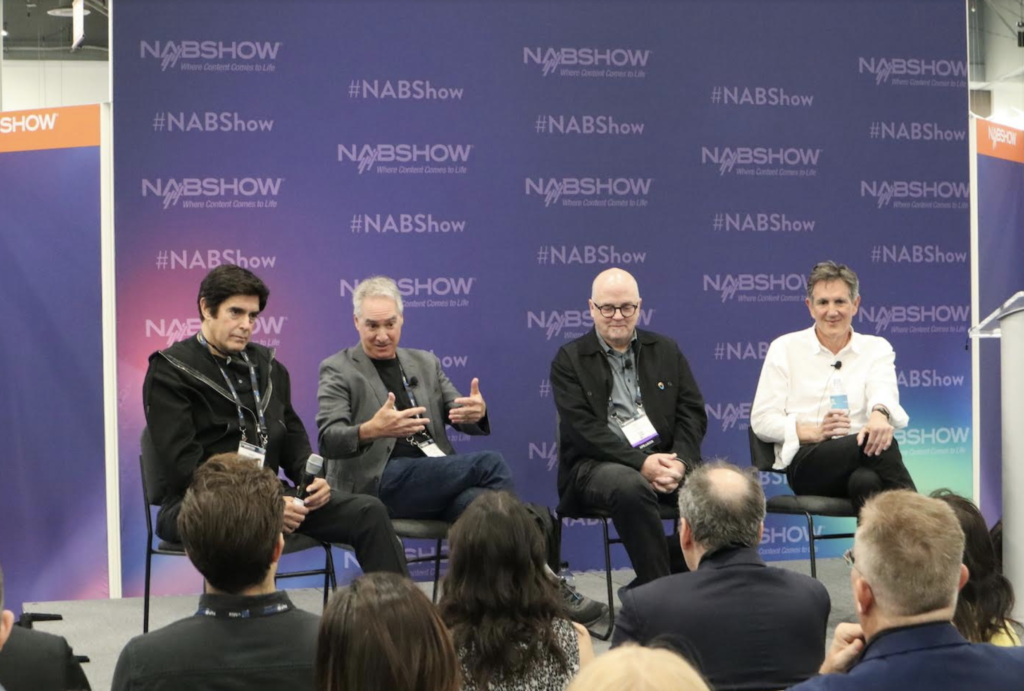M+E Daily

NAB 2022: Film, Tech Sector Experts Tout the Advantages of Scaling Production Services in the Cloud
Story Highlights
Experts from the film and technology sectors used the panel session “Scaling Production Services in the Cloud” at the Intelligent Content Theatre during the NAB Show in Las Vegas to explore the advantages of using the cloud for producing movies and other entertainment. They also touched on the challenges of working virtually.
Noting that he’s been a film producer for many years, Buzz Hayes, global lead of entertainment industry solutions for Google Cloud, said his “least favorite term” is “lift and shift.”
During his 25 years working with animation and visual effects, Hayes told attendees, he “saw a lot of change in the way things are made and any given workflow these days is pretty complicated.” He pointed to the many different types of tools that are used by talents in the sector.
“When you start putting all those pieces together, there’s a lot of bailing wire and tape to hold the system together,” he noted. And, with “any system I’ve ever worked on, not only did I produce movies, [but] I also produced the pipelines themselves,” he recalled.
“Everything always seemed like it was on life support all the time” and there was always “somebody there with a fire extinguisher and a fan to make sure that the show goes on because, as you know, media deadlines are hard and fast” and you can’t miss deadlines, he told attendees.
“So this idea of building workflows that you can just lift and migrate into the cloud is a bit of a myth because if you’re going to be migrating these workloads to cloud, whether it be post-production for live events or non-live events, you really have to think about what efficiencies you can gain from that because it really is about scalability and efficiency,” he explained.
It is in the efficiency “where you’re going to find this migration happening,” he said, adding: “One of the ways I think about production and post-production in the cloud is that the client is the creative, who is the artist trying to solve the hard creative problem.”
Meanwhile, “every day, you’re faced with having to solve a bunch of problems, get a bunch of shots out the door if you’re visual effects artists,” and you’re always racing against the clock trying to solve creative issues, he said.
It is “really hard to budget those from a time perspective,” he noted. “So what you want to do is give people a system that allows them to iterate and reiterate these ideas so that they can fine tune the creative and get it out the door.”
 One thing that everybody really wants to do is “eliminate the progress bars,” he noted, calling them the “bane of everyone’s existence these days” and adding: “How much time have you spent in your life staring at a progress bar? It’s probably measured in days or weeks.”
One thing that everybody really wants to do is “eliminate the progress bars,” he noted, calling them the “bane of everyone’s existence these days” and adding: “How much time have you spent in your life staring at a progress bar? It’s probably measured in days or weeks.”
It is “really important” through all of this to “keep the creative spark alive,” he pointed out, explaining: “When you’re talking about creatives, they have to be able to iterate, fine tune the idea, and then move on to the next one. They can’t have that process interrupted by a progress bar where they’re … waiting and you can just kind of see above their head that creative spark is starting to dim and they have five more shots to get out before six o’clock tonight.”
What that can often lead to is something being compromised, he said.
“So really when we talk about this migration to cloud, it really is a transformation,” he said, pointing out: “It’s more about what tools did the creative use? How do they work best with each other? How can we get them to collaborate better? What are those tools we can put together?”
He then turned his attention to a challenge that’s been widespread since the start of the pandemic.
“Especially now in this virtual world, I used to be able to run down the hall and say to anybody … ‘Can you come take a look at the shot I’m working on. I just need your opinion on this one thing.’ And I could be done with that conversation in 90 seconds.”
However, in today’s ongoing world of virtual work, “now I have to schedule a half hour video meeting to talk about that same 90 seconds,” he said, calling it a “very inefficient thing.”
As a result, it would be a good idea to “get back to this idea that, even virtually, I should be able to tap somebody on the shoulder and say, ‘Do you have a second? I just need your opinion on this just for a minute’ and then be able to move on.”
Fortunately, he said, “that’s where we’re really starting to head because it really is a creative industry that’s supported by technology” – despite the fact that “sometimes I think we get that backwards [and] I think people think it’s a technology industry that’s somehow supported by creative.”
At the end of the day, however, “without the creative, we have no industry,” he pointed out.
“So I tend to think of this as a problem we’re trying to solve for the creatives,” he told attendees, noting these are the folks who are creating all that content we are seeing on the growing number of streaming video services.
“We are now a global workforce” and people want to work “from wherever they’re comfortable,” often in their pajamas, he said.
“So you might as well go to them, give them the tools and services they need, so they can feel like they’re collaborating and that they’re achieving their creative goals,” he added.
Moving from a 2D to 3D world
Ted Schilowitz, futurist for Paramount, told attendees: “We are largely moving from a two dimensional grid of pixels as our day-to-day use case of how we understand video communications, video productivity, personal socialization, personal entertainment, to a three-dimensional Z plane world, which has largely been the stock and trade of the gaming community and the gaming society” up until only recently.
“They moved 35-40 years ago from 2D scrolling worlds to a Z-depth world, but it largely lived in a bit of an insulated community around gamers and deep youth culture,” he noted.
However, “now what’s happening … as we start to talk about production techniques in the cloud, is everybody is starting to move to a sensibility of what Z depth can bring to their world,” he said.
 Meanwhile, the companies that support these workflows, including Epic Games and Unity, who develop game engines, as well as Apple, Google and Microsoft are “all leaning into this,” he said. Those companies also include, “as we lovingly like to call the artist formerly known as Facebook,” he joked, pointing to the billions of dollars that Facebook parent Meta and Google are pouring into virtual reality.
Meanwhile, the companies that support these workflows, including Epic Games and Unity, who develop game engines, as well as Apple, Google and Microsoft are “all leaning into this,” he said. Those companies also include, “as we lovingly like to call the artist formerly known as Facebook,” he joked, pointing to the billions of dollars that Facebook parent Meta and Google are pouring into virtual reality.
In the process, “we’re bringing the elements of live performance” into the world of traditional home and mobile entertainment, he noted.
As a result, some people are already wearing devices on a daily basis to access such entertainment, including virtual, mixed and other types of alternative reality technology.
Increasingly, “what’s coming is this spatial universe is moving out of just the domain of gamers into the domain of everybody in almost every industry,” going even beyond entertainment to sectors that also include healthcare and productivity, he said.
Schilowitz also pointed out that the virtual world is how he was able to become good friends with magician David Copperfield, the session’s special guest speaker, in recent years.
“I’m a seat filler today,” Copperfield said, drawing laughs. Magicians have always been involved in technology, including film, Copperfield said. Magicians always been involved in tech including movies, he added, pointing to Georges Méliès, a French illusionist who is also widely considered the first film director.
Noting he is a “sponge” who wants to learn more about all the latest technology, Copperfield went on to say one challenge is often the things that are supposed to be making it easier and quicker for creatives to do their work end up making it harder instead.
David Goldman, founder and CEO of the Cornax Cloud Alliance, served as the panel session’s moderator.









